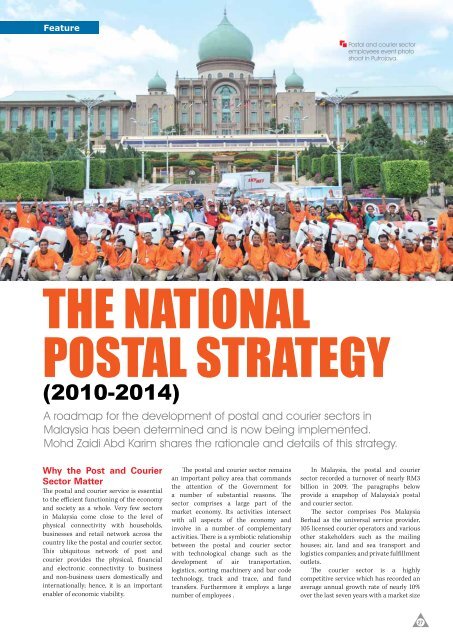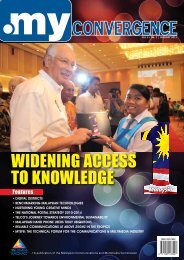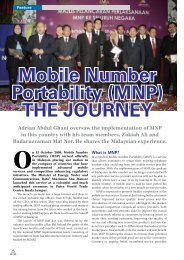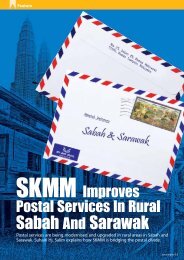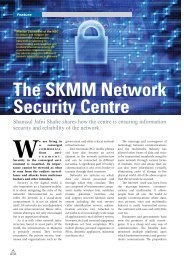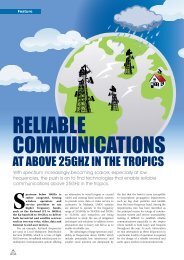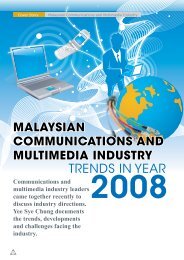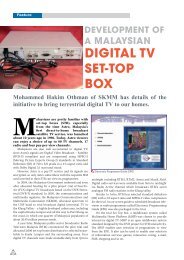THE NATIONAL POSTAL STRATEGY - my Convergence Magazine
THE NATIONAL POSTAL STRATEGY - my Convergence Magazine
THE NATIONAL POSTAL STRATEGY - my Convergence Magazine
Create successful ePaper yourself
Turn your PDF publications into a flip-book with our unique Google optimized e-Paper software.
FeaturePostal and courier sectoremployees event photoshoot in Putrajaya.<strong>THE</strong> <strong>NATIONAL</strong><strong>POSTAL</strong> <strong>STRATEGY</strong>(2010-2014)A roadmap for the development of postal and courier sectors inMalaysia has been determined and is now being implemented.Mohd Zaidi Abd Karim shares the rationale and details of this strategy.Why the Post and CourierSector MatterThe postal and courier service is essentialto the efficient functioning of the econo<strong>my</strong>and society as a whole. Very few sectorsin Malaysia come close to the level ofphysical connectivity with households,businesses and retail network across thecountry like the postal and courier sector.This ubiquitous network of post andcourier provides the physical, financialand electronic connectivity to businessand non-business users domestically andinternationally; hence, it is an importantenabler of economic viability.The postal and courier sector remainsan important policy area that commandsthe attention of the Government fora number of substantial reasons. Thesector comprises a large part of themarket econo<strong>my</strong>. Its activities intersectwith all aspects of the econo<strong>my</strong> andinvolve in a number of complementaryactivities. There is a symbiotic relationshipbetween the postal and courier sectorwith technological change such as thedevelopment of air transportation,logistics, sorting machinery and bar codetechnology, track and trace, and fundtransfers. Furthermore it employs a largenumber of employees .In Malaysia, the postal and couriersector recorded a turnover of nearly RM3billion in 2009. The paragraphs belowprovide a snapshop of Malaysia’s postaland courier sector.The sector comprises Pos MalaysiaBerhad as the universal service provider,105 licensed courier operators and variousother stakeholders such as the mailinghouses; air, land and sea transport andlogistics companies; and private fulfillmentoutlets.The courier sector is a highlycompetitive service which has recorded anaverage annual growth rate of nearly 10%over the last seven years with a market size27
Courier companies’delivery men in actionof nearly RM1.7 billion recorded in 2009.The sector includes international giantssuch as DHL, FedEx, UPS and TNT.Each day about three million pieces ofpostal articles are being delivered to morethan 6.3 million addresses nationwide.Over 80% of mail is business mail whichdemonstrates the extent to which postalactivity is integrally related to marketactivity such as advertisement mail,financial reporting, e-commerce, smallbusinessmarketing and so on.More than 20,000 postmen and courierson a daily basis dedicated themselves toensure letters, magazine, advertisement,small package, parcel and express itemsare delivered to the recipients throughoutthe country.The post office network comprisingmore than 1,000 outlets nationwide is animportant channel for the community withabout 100 million transactions amountingto nearly RM15 billion recorded in 2009.The sector remains a labour intensivesector with more than 34,000 workers.As businesses adopt “just-in-time”production and strategies, the courieroperators have played an increasinglyimportant role in warehousing, logisticsand supply-chain management. Theinternational and domestic courier andexpress network supports some of thekey national economic engines suchas the electrical and electronic sector;the exchanges of specimens betweenbio-technology research and developmentcentres; and the financial sector such asdelivery of cheques and credit cards toname a few.Changing EnvironmentThe Government recognises that the postalmarket is undergoing profound changes.Mail volumes in most part of the worldare declining as a result of electronicsubstitution which is threatening thesustainability of universal postal serviceprovisioning. To meet this challenge, thepostal operator must step up its effort tomodernize postal network, innovate anddiversify its product portfolio, deliver highquality of service and develop humancapital to ensure that it remains relevantto the consumers in the market place. Onthe bright side, the consumption of a smallpacket and parcel service is expected togrow in tandem with the development ofLevelofAccessTelegraph(1835)Telephone(1975)Steam-PoweredLocomotive (1804)Gas-PoweredAutomobile (1885)Timee-commerce and online businesses aspeople and businesses still require postalarticles and goods to be moved efficientlyfrom one place to another as shown inthe level of physical and informationaccess trend in Exhibit 1 below.As the nation grows from a middleincome econo<strong>my</strong> to a high incomeecono<strong>my</strong> by 2020, the postal and courierservice is expected to raise its qualityand performance bar, to become animportant component and integral partof the economic activities, and to providequality jobs for the population. However,the future operating environment haschanged from the present with manygreat challenges driven by the followingfactors:• Challenging economic scenario• High fuel prices• Changing consumer behaviour• Technological change which providesboth the positive and negative impactto the overall growth of the sector• Greater liberalisation in both postaland courier market worldwide• Climate change• Population increase and urbanisationTelefax Widelyuse (1960’s)Internet Widelyuse (1990’s)Airplane(1903)OvernightDelivery (1973)AdvancedLogistics1800 1900 2000Access toInformationAccess toPhysicalExhibit 1: The Level of Physical and Information Access Has Risen Dramatically Over TimeThe modernisation of thepostal sector forms part of the NPS28
A Pos Malaysia employee processing mailThey are designed to meet the changingneeds of customers, market andoperating environment driven mainly bythe information revolution, globalization,and the changing economic climate.The framework has been adoptedfrom the Universal Postal Union's (UPU)Strategy Framework with some finetuning to suit the local environment.Established in 1874, the UPU withits headquarters in the Swiss capitalBerne, is the second oldest internationalorganisation worldwide. With its 191member countries, the UPU is theprimary forum for cooperation betweenpostal sector players. It helps to ensurea truly universal network of up-to-dateproducts and services. In this way,the organisation fulfils an advisory,mediating and liaison role, and providestechnical assistance where needed. Itsets the rules for international mailexchanges and makes recommendationsto stimulate growth in mail, parcel andfinancial services volumes and improvequality of service for customers.The NPS is organised around the fivestrategic thrusts (Exhibit 3) and whichare elaborated as follows.Sustainable UniversalPostal ServiceThe first thrust aims to stimulate asustainable universal postal servicewhich is adapted to the social, economicand technological environment.Programmes will be carried out toachieve this objective. The Governmentwill work towards developing a universalpostal regulation and criteria. It will alsobuild a robust tariff regime. A fundingmodel for universal postal service willalso be established along with improvedaccess to postal outlets nationwide andlastly, a programme to improve maildelivery service coverage in rural areas.Improve Service QualityAnother objective is to ensure theprovision of timely, reliable delivery andimproved customer service across allaccess points.Here work will be done to develop aquality of service performance standardas well as a measurement system for thepostal and express services. There willalso be focus on enhancing consumersatisfaction and in stimulating theuse of technology to improve serviceperformance. Lastly steps will be takento enhance security and trust.Industry GrowthThe third thrust fosters the growth ofthe physical, electronic and financialdimensions of the postal and expressmarkets.One of the programmes that willbe undertaken will promote faircompetition through appropriateregulation whilst fostering cooperationamong industry stakeholders. Growthwill be fostered through the developmentof new products and services. Theexpress service sector coverage wouldalso be expanded nationwide.A robust licensing regime is expectedto be developed under this thrust. Yetanother programme will nurture increaseinvolvement in electronic commerce andservice. Efforts that promote philatelicinterest nationally will also be taken.Improve ProductivityAnother thrust seeks to improveproductivity through human capitaldevelopment, process innovation andmechanisation.Programmes will be undertakento stimulate the use of technology toimprove productivity. Among them will beautomation of mail and parcel handlingas well as self service terminals. Anotherprogramme will promote network sharing.Human capital development andcapacity building exercises will beundertaken. National postal addressingand postcode systems will be improved.At the same time, this trust will alsoundertake programmes that protect theenvironment. The promotion of a healthand safety culture will be another priorityprogramme.International DevelopmentThe fifth and final thrust will focus onenhancing the profile of the nation in theinternational arena.The nation will play a leadership rolein the Universal Postal Union (UPU) andAsian Pacific Postal Union (APPU). Itwill seek top leverage on the Free TradeAgreements and also escalate Malaysia’sstanding in international fora. Malaysia’sconnectivity to the international postaland courier network will be strengthened.Exhibit 4 shows all the thrusts andprogrammes in the context of the visionand mission of the National PostalStrategy.30


